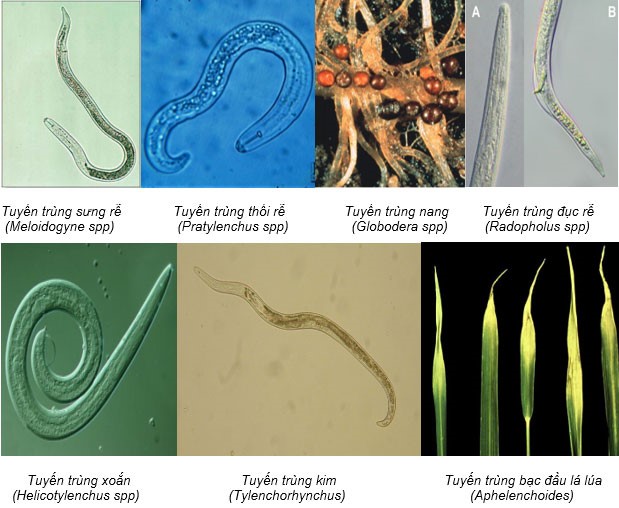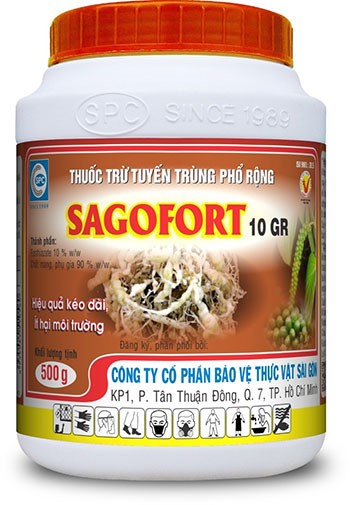|
NEMATODE ELIMINATING SAGOFORT 10 Gr
21/06/2023
NEMATODE ELIMINATING SAGOFORT 10 Gr 26/05/2022 Active ingredient: Fosthiazate 10% w/w Sagofort 10 GR is a contact nematode, granular form, with active ingredient Fosthiazate, organophosphate base, Achetylcholine esterase inhibitory action, both killing (nematicide) and inactivating (nemastatic ) effects. ) so effect lasts, effective control of many types of nematodes: Root-knot nematodes (Meloidogyne), root rot nematodes (Pratylenchus), cyst nematodes (Globodera), root borer nematodes(Radopholus), spiral nematode (Helicotylenchus), needle nematode (Tylenchorhynchus), rice leaf tip white nematode (Aphelenchoides) and free soil nematode, the product is relatively less toxic compared to other nematodes available on the market Do not leach down , so it do not pollute groundwater, do not accumulate in the environment, are less toxic to beneficial organisms such as earthworms and fish, and are less affected by soil properties (sandy soil, clay, loamy sandy soil ). clay, red basalt soil,…) pH, moisture and soil temperature,... Therefore, Therefore, Sagofort 10GR synthesizes two effective and environmentally friendly factors at the same time, used by many countries around the world to eliminate nematodes on many crops such as bananas, vegetables, tomatoes, peppers, peppers, etc. potatoes, radishes, fruit trees, etc. Common dosage: 1.5 - 3.0 kg ai/ha (15-30 kg Sagofort 10Gr/ha). P.H.I: 30 days.
Direction for uses:
Note: - On black pepper, when fertilizing, the soil should be lightly plowed, taking care not to break the roots, then spread the product at a distance of 30-40 cm from the root, cover with soil and water lightly. - Because Sagofort 10Gr is a broad-spectrum nematicide, it can be used to eliminate nematodes on many crops such as citrus trees, bananas, coffee, cabbage, potatoes, carrots, watermelons, etc. - Soil with many nematodes should be treated in 2-3 waves: early, middle and late rainy season. - Can combine treatment of Sagofort 10GR with decomposed organic fertilizer. - Although it is a relatively low-toxic and environmentally friendly product, it is necessary to follow the instructions on the package and pay attention to the isolation period.
|
To prevent, in addition to plowing and burying weed seeds, collecting weed stalks and stumps left after tilling the land to burn, not letting weeds produce seeds in production fields, etc., the use of chemical products is still a measure. optimal because of its ability to thoroughly kill weeds, reduce labor and take advantage of more time than manual weeding.
Miner has the scientific name Phyllocnistis citrella Staint., family Phyllocnistidae, order Lepidoptera. The miner occurs in many countries in the tropics and subtropics. The main host of the miner is the citrus family - Rutaceae. In addition, the miner also attacks mangosteen and some other plants.
Adult is a small planthopper, with a body 2-3 mm long, the whole body is ash gray, slightly greenish, the wings are opaque with many small brown spots.Eggs are oval, 0.3 mm long, have a pointed end and are attached directly to the leaf surface, leaf axils.
Green bugs specialize in the fruit of citrus groups (oranges, tangerines, lemons, grapefruits, kumquats...), some people call them orange bugs, or orange suckers. Their scientific name is Rhynchocoris poseidon or Rhynchocoris humeralis.
In Vietnam, yellow leaf curl disease is very common on papaya trees, especially the disease is often severe in areas of high and continuous planting, areas with hot and arid climates. The disease has significantly reduced the yield and quality of papaya. Gardens that are infected early when the plants are young may not yield. However, up to now, many gardeners still do not know the cause and how to fix it.
Spider mites are common pests on citrus trees, especially in hot and dry climates that are suitable for spiders to grow and cause severe damage.The group of harmful spiders is usually very small in size, unlike the natural enemy spiders.
This group includes species that are generally very small in size, causing damage by sucking plant sap (on leaves, fruits, branches, stems).
There are many species of mealybugs present on the group of Oranges,Tangerines,Grapefruits and Lemons (Citrus), which can be divided into 2 groups:
+ Group of sticky mealybugs with common varieties such as Lepidosaphes, Aonidiella, Coccus and Saissetia.
+ Group of flower mealybugs with common genera and species such as Pseudococcus, Planococcus and Icerya purchasi.
Dry branches and berries disease often appear to be common damage on coffee gardens during the rainy season. The disease causes death of branchs, dry fruit, severely affects the canopy structure and coffee yield if not paid attention to prevention.
Pink disease commonly causes diseases on rubber plantations in the rainy season, especially on garden from 4-8 years old. This year, rubber has to go through a period of severe drought, weakening the tree, so now in tnshe rainy season it is easy to get infected. Therefore, it is necessary to pay attention to good management to avoid affecting the garden.
In recent years, the area of citrus has been expanded because it is a fruit tree with high economic efficiency. However, in order to sell at a high price, not only in quality but consumers also require the external beauty of the fruit, so pest management on citrus is a matter of great concern to farmers. The hot season is a favorable condition for thrips to develop and cause damage, affecting the commercial value of fruit.
- Headquarters
- SAIGON PLANT PROTECTION JOINT STOCK COMPANY
- RQ 1, Nguyen Van Quy St., Tan Thuan Ward, HCM City
- Tax code: 0300632232
- Tel: (028) 38 733 295 - 38 732 077
- Fax: (028) 38 733 003 - 38 733 391
- Website: www.spchcmc.vn - Email: info@spchcmc.vn
- SAIGON PLANT PROTECTION COMPANY
- SAIGON PLANT PROTECTION JOINT STOCK ENTERPRISE
- Lot C1-C3 Hiep Phuoc Industrial Park, Hiep Phuoc Commune, HCM City
- Tel: (028) 3873 4089 - Fax: (028) 3873 4086
- Affiliated Unit
-
- Quick Links
- Home
- About us
- Career Opportunities













